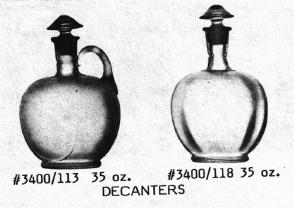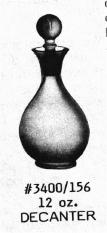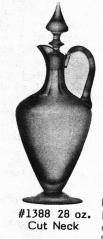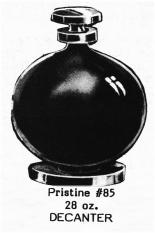Cambridge Decanters, Part V
by Mark A. Nye
Issue No. 147 - July 1985
In the last article of this current series (published in the May Crystal Ball), a discussion of the decanters pictured in the 1940 Cambridge catalog was commenced. This month's article continues the coverage of decanters available from that catalog.
We'll start with two items from the #3400 line: #3400/113 35 oz. handled decanter, and the #3400/156 12 oz. decanter, both of which came with ground stoppers. The later decanter utilized the typical #3400 line stopper, round in shape and with the characteristic pattern, while the #3400/113 decanter has a stopper that appears unique to it and the #3400/118 decanter. This later decanter differs from the #3400/113 only in that it does not have the applied handle.
 Discontinued before 1940, the #3400/118 decanter was perhaps made in
many of the same colors and with the same decorations as the handled
#3400/113 version during the 1930s. However, known price lists do not
support this and we will have to await the discovery of additional
price lists from the 1930s to prove or disprove this theory.
Discontinued before 1940, the #3400/118 decanter was perhaps made in
many of the same colors and with the same decorations as the handled
#3400/113 version during the 1930s. However, known price lists do not
support this and we will have to await the discovery of additional
price lists from the 1930s to prove or disprove this theory.
The first picture of the #3400/113 decanter appeared in the 1933 Cambridge catalog supplement, and of the #3400/156 in the 1934 supplement. Both decanters, however, may date to 1931-32. While there is no catalog or price list reference for decorated #3400/156 decanters, the #3400/113 was offered etched Elaine, Diane and Portia in the 1940 catalog.
Although by 1940 the #3400/113 decanter was being produced only in crystal and royal blue, other colors may have been utilized for this piece during the 1930s. The January 1940 price list offered the #3400/156 in crystal, amber, forest green, royal blue and amethyst. Again, other colors from the 1930s might be possible.
 During the 1930s and into the 1940s, the #3400/156 decanter (right) was sold
by itself or as part of a set. The 1934 Cambridge catalog supplement
pictured an 8-piece set made up of the #3500/112 tray, #3400/156
decanter and six #1327 1 oz. cordials. A wholesale jewelers' catalog
originally issued in 1935 and in part reprinted in the April 1978
CRYSTAL BALL, pictured two Farberware sets utilizing a decanter
identical in shape to the #3400/156 but listed as holding 18 oz. At
this time, it is not known if the difference in stated capacity was due
to the method of measurement or if the Farber Bros. had a separate mold
made. Each set used three decanters in Farberware holders and the color
choices were described thus, "Sets come with glass in the following
colors: Green, Amber, Amethyst, and Blue." The sets were each called
"Tantalus Set" and one came with a locking device. Quoting from the
advertisement, "The owner of this set may have no fear of his servants
drinking up his whiskies. He has them under lock and key."
During the 1930s and into the 1940s, the #3400/156 decanter (right) was sold
by itself or as part of a set. The 1934 Cambridge catalog supplement
pictured an 8-piece set made up of the #3500/112 tray, #3400/156
decanter and six #1327 1 oz. cordials. A wholesale jewelers' catalog
originally issued in 1935 and in part reprinted in the April 1978
CRYSTAL BALL, pictured two Farberware sets utilizing a decanter
identical in shape to the #3400/156 but listed as holding 18 oz. At
this time, it is not known if the difference in stated capacity was due
to the method of measurement or if the Farber Bros. had a separate mold
made. Each set used three decanters in Farberware holders and the color
choices were described thus, "Sets come with glass in the following
colors: Green, Amber, Amethyst, and Blue." The sets were each called
"Tantalus Set" and one came with a locking device. Quoting from the
advertisement, "The owner of this set may have no fear of his servants
drinking up his whiskies. He has them under lock and key."
To return to a decanter covered in Part I of this series, this same
wholesale jewelers' catalog also pictured a decanter identical in shape
to the 32 oz. #3400/92 ball shape decanter, but listed as holding 38
oz. and shown in a Farberware holder. In one illustration it was shown
with 1 oz. brandies made up of a #3126 bowl and a metal stem.
 In another picture the same decanter was accompanied by 2 oz. flat
tumblers in metal holders. Both sets came with a metal tray and the
color availability was the same as given above for the #3400/156
set.
In another picture the same decanter was accompanied by 2 oz. flat
tumblers in metal holders. Both sets came with a metal tray and the
color availability was the same as given above for the #3400/156
set.
Production of the #3400/113 and the #3400/156 decanters ceased sometime during the 1940s with royal blue and forest green items no longer being made after 1943.
The #1388 28 oz. handled and footed decanter (pictured at left) is simply a variant of the #1321 sherry decanter discussed in Part I.
The #1388 has an applied handle, a pouring spout and uses a different style of ground stopper with a body shape that is identical to the #1321. Even though the first known Cambridge catalog illustration of the #1388 is in the 1934 catalog supplement, it may go back a few more years since #1321 decanters were in production by 1931.
The #1388 decanter is not shown etched in the 1930-34 catalog nor is it listed etched or otherwise decorated in the 1940 price list. However, this does not rule out the possibility it was etched during the mid-to-late 1930s. During the late 1930s, at least, the rock crystal cuttings Lucia, Laurel Wreath, Exeter, Concord and Lexington were used to decorate the #1388 decanter. In addition to these decorations, this decanter was illustrated in the 1934 catalog supplement with a cut neck.
Colors listed in 1940 for the #1388 decanter were crystal, amber,
forest green, royal blue and amethyst. Earlier production in the 1930s
 pastels and perhaps even carmen cannot be ruled out. Like all decanters
in this article, production of the #1388 had ceased by 1949.
pastels and perhaps even carmen cannot be ruled out. Like all decanters
in this article, production of the #1388 had ceased by 1949.
While not available in 1940 (having been already discontinued) there is a 14 oz. version of the #1388. Known as the #1387, it was first pictured in the 1934 Cambridge Catalog supplement. Identical in every way except size to the #1388, the #1387 was probably intended to be a cordial decanter. Unfortunately, no information about the 14 oz. size regarding color and decorations has been found.
 Our next item is from the Pristine line and it is the Pristine #85
28 oz. footed decanter (shown at right) with a cut top stopper, polished in. In all
probability made only in crystal and with the typical Pristine foot,
this decanter would have been made first in 1936-37 and was dropped
from the Cambridge line during the 1940s.
Our next item is from the Pristine line and it is the Pristine #85
28 oz. footed decanter (shown at right) with a cut top stopper, polished in. In all
probability made only in crystal and with the typical Pristine foot,
this decanter would have been made first in 1936-37 and was dropped
from the Cambridge line during the 1940s.
During the late 1930s and possibly continuing into the early 1940s, the P85 decanter was decorated with the rock crystal cuttings Fantasy, Strawflower, Killarney, Neo Classic, The Pines, Etruscan and Grecian. Three other cuttings, Sunburst, Lexington and Bexley are also known on this decanter and these were possibly done during the early 1940s. The P85 decanter was also decorated with the decorations D/1050, etched Laurel and gold encrusted, and D/450 Astoria.
Based on its number, the tall bottle like decanter known as #1372 and pictured at left would date to the early 1930s. However, no picture of it appears in the 1930-34 catalog as reprinted by the NCC, Inc. While it is also given the designation Pristine #90 in the 1940 catalog and included in the Pristine listings as #90 28 oz. tall decanter, cut stopper polished in, this decanter is not readily identified with the Cambridge Pristine line. The P90 or #1372 decanter was either a popular one or Cambridge hoped it would be since it was extensively used for etchings. Minerva, Valencia, Wildflower, Elaine, Diane, Portia and Rose Point were all placed on this decanter during the late 1930s and, except for the first two, also during the early 1940s.
Made only in crystal during the late 1930s and early 1940s, it was also available with D/1014 gold edged and etched Elaine and D/1041 Rose Point with a gold edge.
It is known the P90 decanter was also decorated with the rock crystal cuttings Adonis and Croesus during the late 1930s.
In Part IV of this series of articles, I mentioned that the #1542 Life Saver decanter was known with a cutting, but provided no additional information. Research done since that article was written has identified two cuttings that can be found on the Life Saver decanter. These are #1039 and #1047 (see accompanying photos). The references found so far for these cuttings do not provide names.
To be continued ...
